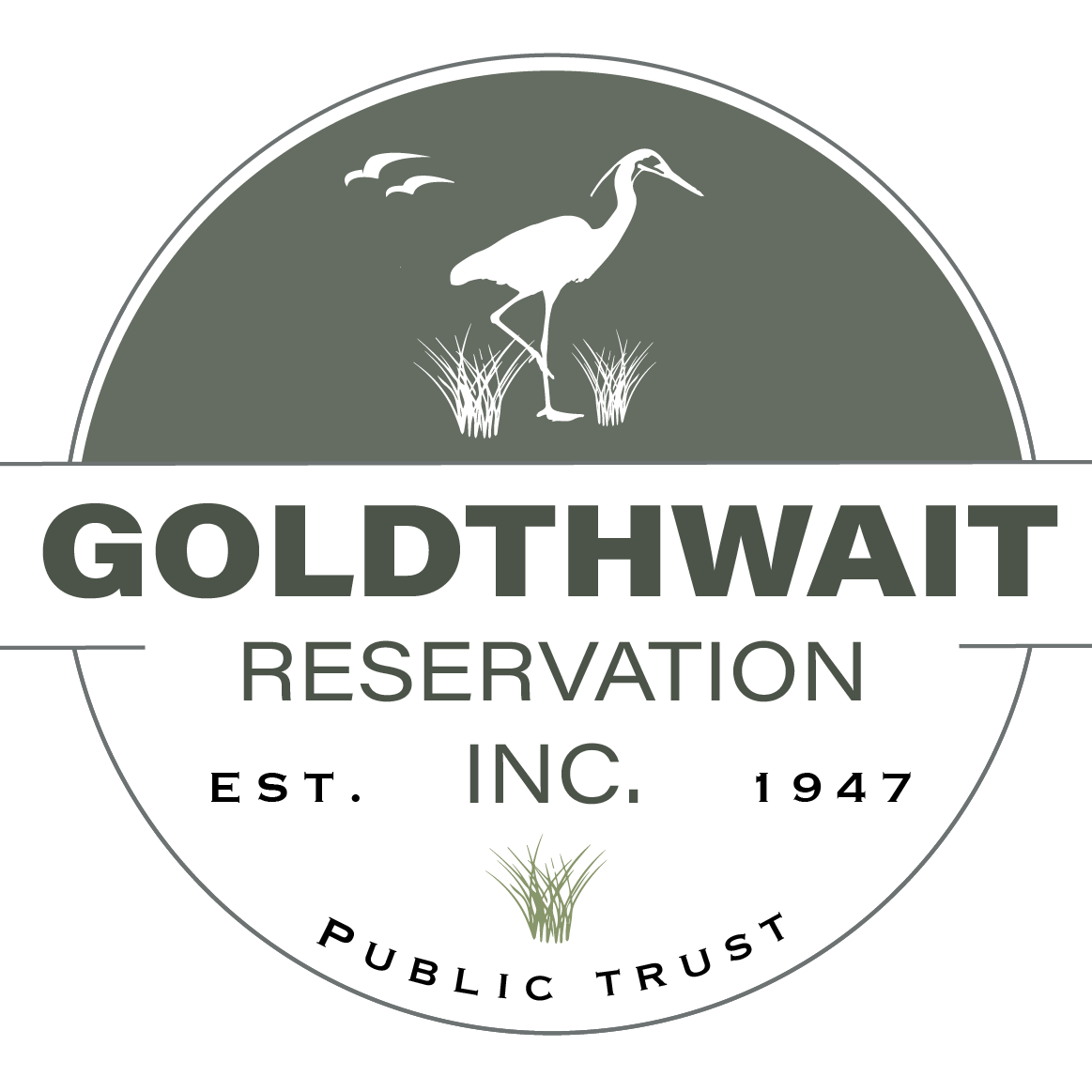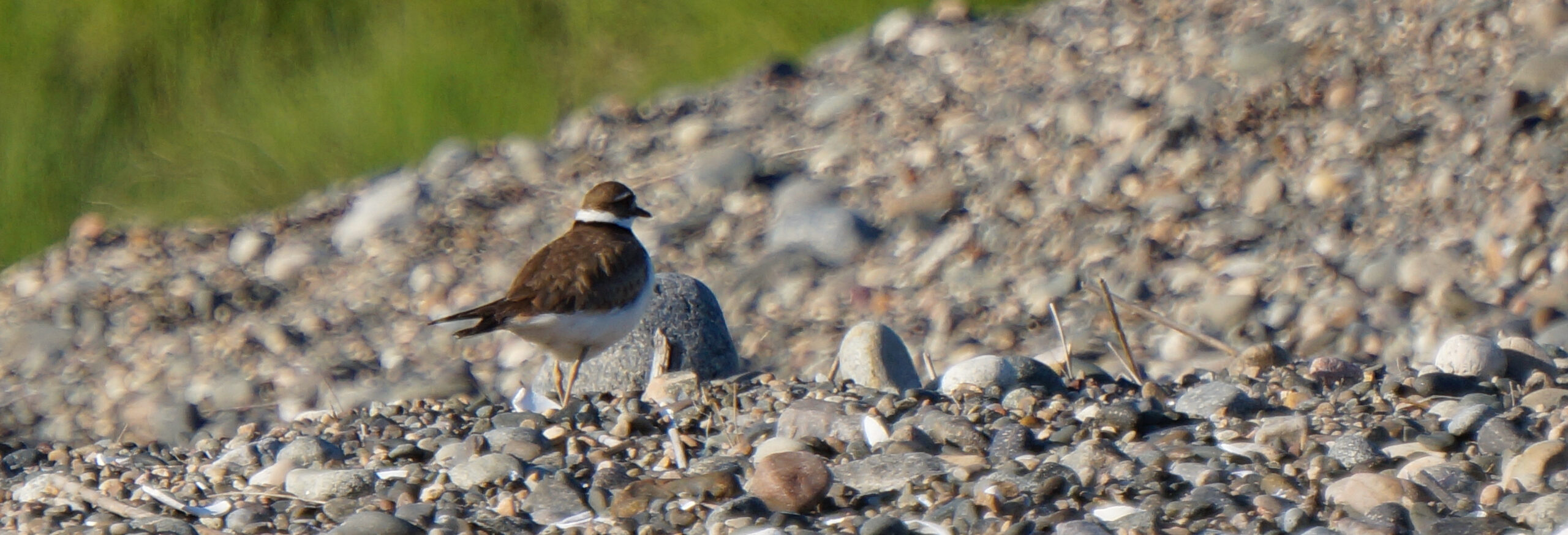A delightful animated video that explores the sights and sounds of the Goldthwait Reservation. This video was produced by Issac Grenader, a sophomore at the Rhode Island School of Design, who studies experimental animation and film. He explores themes of nature and conservancy in his work, and is also a musician.
Fish
 Killifish – The name killifish is derived from the Dutch word “kilde,” meaning small creek or puddle. Most killies are small fish, averaging 1-2 inches long. Killifish provide food for wading birds, aerial birds, and some ducks. Fishers also use them as bait while fishing. Killifish feed primarily on aquatic arthropods such as insect (mosquito) larvae, aquatic crustacean, and worms.
Killifish – The name killifish is derived from the Dutch word “kilde,” meaning small creek or puddle. Most killies are small fish, averaging 1-2 inches long. Killifish provide food for wading birds, aerial birds, and some ducks. Fishers also use them as bait while fishing. Killifish feed primarily on aquatic arthropods such as insect (mosquito) larvae, aquatic crustacean, and worms.
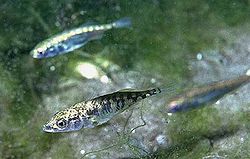 Stickleback – These small 3-inch torpedo-shaped fish, which are closely related to pipefish and seahorses, have no scales (though some species have bony armor plates), and are characterized by isolated spines in their dorsal fins. Sticklebacks feed on small animals such as insects, crustaceans, and fish larvae. Sticklebacks can be found in both ocean-water and freshwater environments.
Stickleback – These small 3-inch torpedo-shaped fish, which are closely related to pipefish and seahorses, have no scales (though some species have bony armor plates), and are characterized by isolated spines in their dorsal fins. Sticklebacks feed on small animals such as insects, crustaceans, and fish larvae. Sticklebacks can be found in both ocean-water and freshwater environments.
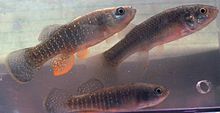 Mummichog – The mummichog is a type of killifish that is capable of tolerating highly variable salinity and temperatures, and is found in estuaries and saltmarshes, as well as less salty waters. Mummichogs spawn on new and full moons in the spring and summer. Mummichog eggs are laid near the high tide mark and can tolerate long-term exposure to air. The eggs are used in teaching embryology, because it is possible to see the eyes and the beating heart and follow the different stages of ontogenesis.
Mummichog – The mummichog is a type of killifish that is capable of tolerating highly variable salinity and temperatures, and is found in estuaries and saltmarshes, as well as less salty waters. Mummichogs spawn on new and full moons in the spring and summer. Mummichog eggs are laid near the high tide mark and can tolerate long-term exposure to air. The eggs are used in teaching embryology, because it is possible to see the eyes and the beating heart and follow the different stages of ontogenesis.
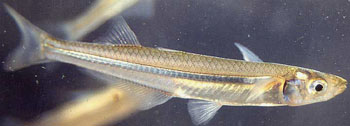 Atlantic Silverside – This small fish is a common subject of scientific research due to its sensitivity to environmental changes. Silversides prefers brackish water where rivers and streams meet the ocean and they are typically found a few feet away from the water’s edge, swimming in the underwater grasses that help protect them from predators. During winter, most silversides swim to deeper water to avoid cold temperature.
Atlantic Silverside – This small fish is a common subject of scientific research due to its sensitivity to environmental changes. Silversides prefers brackish water where rivers and streams meet the ocean and they are typically found a few feet away from the water’s edge, swimming in the underwater grasses that help protect them from predators. During winter, most silversides swim to deeper water to avoid cold temperature.
BIRDS
Many bird species have been noted to occur at the Goldthwait Marsh and Riverhead Beach area and many more could potentially occur there. Wading birds, ducks, diving birds, gulls, terns, and shorebirds make up the dominant groups. To a much lesser degree, passerines, such as warblers, wrens, and sparrows, may stop over and rest and feed at the upland portion of the beach among the shrubs and upland weeds. The following table lists the species of birds that have been sited and their main source of food.
| Great Blue Heron (Ardea herodias) Feed upon small fish, crabs, small rats, and mice. |
| Snowy Egret (Egretta thula) Feed upon mostly aquatic animals, including fish, frogs, worms, crustaceans, and insects. It often uses its bright yellow feet to paddle in the water or probe in the mud, rounding up prey before striking with its bill. Snowy Egrets forage in the saltmarsh pools, tidal channels, and tidal flats of Goldthwait and Riverhead. |
| Black-Crowned Night Herons (Nycticocorax nycticorax) Feed upon shrimp, squid, clams, mussels, crabs, and minnow; usually feed at dusk. |
| Black Duck (Anas rubripes) and Mallard (Anas platyrhynchos) Feed upon snails, mussels, and periwinkles along with some vegetation. |
| Brant (Branta bernicla) 80% of their diet is eelgrass (Zostera marina), while the other 20% is sea lettuce (Ulva lactuca) and sea cabbage (Enteromorpha); Brants have suffered a tremendous decline due to hunting and the disappearance of eelgrass beds, but have made a comeback, due to decreased hunting and a widening of its diet. This species may occur at Riverhead Beach occasionally in the winter or on its way to its breeding grounds in the spring. |
| Canada Goose (Branta canadensis) Feed upon vegetation, mollusks, and small crustaceans at Riverhead. |
| Bufflehead (Bucephala albeola) Feed upon shrimp, small crustacean, and snails. |
| Common Eider (Somateria mollissima) Prefer shallow waters and rocky shores where they feed exclusively upon animals, such as mussels, clams, urchins, starfish, sculpins, and crustaceans. |
| Common Goldeneye (Bucephala clangula) Typically feed in waters less than 10 feet in depth upon similar food to the Common eider. |
| Common Merganser (Mergus merganser) and Red-Breasted Merganser (Mergus serrator) Feed primarily on minnows, killifish, and sticklebacks. |
| Common Loons (Gavia immer) and Red-Throated Loons (Gavia stellata) Feed upon flounder, herring, sculpins, and sandlances. |
| Red-Necked Grebes (Podiceps grisegena) and its rare relative, the Orned Grebe (Podiceps auritu) Feed upon small fish such as sticklebacks and silversides. |
| Cormorants (Phalacrocorax auritus) Feed upon fish in the area. |
| Herring Gulls (Larus argentatus) and Greater Black-Backed Gulls (Larus marinus) Feed upon almost anything, including small fish, garbage, crustaceans, mollusks, worms, sea urchins, starfish, and rodents. |
| Bonaparte’s Gulls (Larus Philadelphia) and Ring Billed Gulls (Larus delawarensis) Feed upon mudworms and crustaceans. |
| Glaucus Gulls (Larus hyperboreus) These gulls harass other birds for fish and mollusks and prey upon urchins and starfish; not common in the area. |
| Iceland Gulls (Larus lecucopterus) and Laughing Gulls (Larus atrilla) Feed on fish, carrion, marine invertebrates, occasionally eggs and young of other birds; some terrestrial plants, algae, and berries in late summer. |
| Common Terns (Sterna hirundo) Prey upon small fish such as pipefish and mackerel; have been noted at Riverhead. |
| Least Terns (Sterna antillarum) and Roseate Terns (Sterna dougallii) Both are on the federal list of endangered species and may occur in the area. |
| Semipalmated Sandpipers (Calidris pusilla), Greater Yellowlegs (Tringa melanoleuca), and Dunlin (Calidris alpina), as well as less common species, such as the Buff-Breasted Sandpiper (Tryngites subruficollis) Riverhead Beach may be an important stopover for migrating shorebirds–more so than Devereaux due to Riverhead’s sheltered nature and less human disturbance. The various shorebirds feed upon a variety of food, ranging from minute crustaceans, small mollusks and marine worms, to beach fleas (Talitridae), killifish, and minnows. |
| Peregrine Falcons (Falco peregrinus) Though extremely rare, peregrines do migrate along the coast and are occasionally noted at Plum Island feeding upon shorebirds; this species has been noted at the site. |
| Red-Winged Blackbirds (Agelaius phoeniceus) In the summer, these blackbirds feed on mainly insects; in the winter, they feed on seeds, including corn and wheat. Sometimes they feed by probing at the bases of aquatic plants with their slender bills, prying them open to get at insects hidden inside. |
MAMMALS
Raccoons (Procyon lotor), which often forage along coastlines, are noted in Marblehead at night, as well as striped skunks (Mephitis mephitis) and opposums (Didelphis marsupialis). All of these animals are common throughout the area and at Riverhead Beach and likely feed upon crabs and other crustacea, various mollusks, sea urchins, mice, and whatever other food they may scavenge. Brown rats (Rattus norvegicus) and black rats (Rattus rattus) also inhabit the area. The Goldthwait Reservation also provides suitable habitat for muskrats (Ondatra zibethicus), Easter cottontails (Sylvilagus floridanus), and various species of mice, voles and shrews. Red fox (Vulpes fulva) have been noted in the area. Though no siting of the Mink (Mustela vsison) or the long-tailed weasels (Mustela frenota) have been noted, these animals are known to forage along beaches at night and therefore it is not unrealistic to assume that these species may occur in the area. Harbor seals (Phoca Vitulina), which are common along the coastline of the north shore during the winter months, may also occur along Riverhead Beach. It is unlikely that the area is an important staging area however, due to its location at the inner point of the Harbor.
THREATENED AND ENDANGERED SPECIES
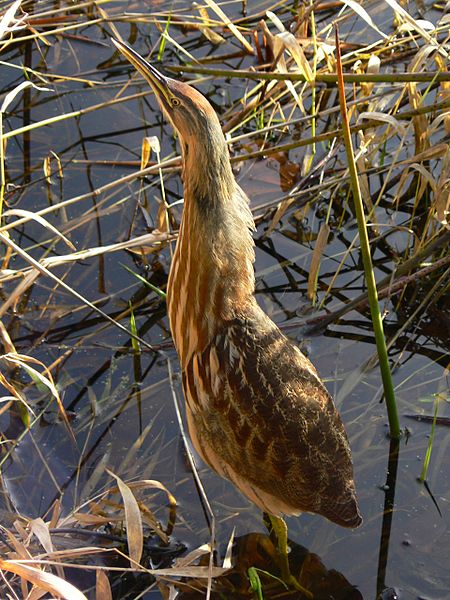 American Bittern (Botaurus lentiginosus) | 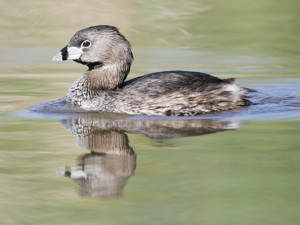 Pied-billed Grebe (Podilymbus podiceps) Pied-billed Grebe (Podilymbus podiceps) |
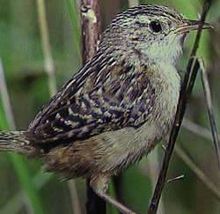 Sedge Wren (Cistothorus platensis) | 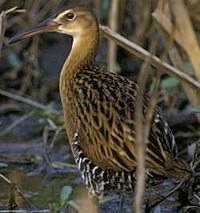 King Rail (Rallus elegans) |
 Common Moorhen (Gallinula chloropus) | 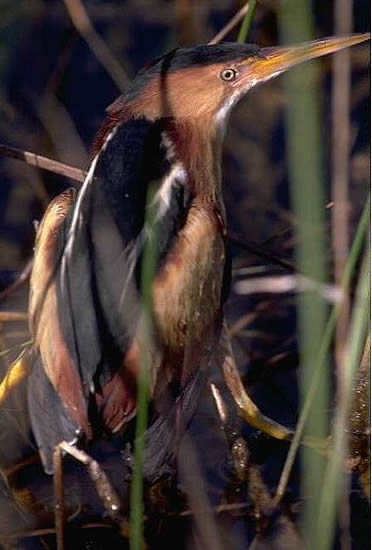 Least Bittern (Ixobrychus exilis) |
Several types of marsh bird populations are in serious decline in Northeastern Massachusetts. Please refer to the Natural Heritage and Endangered Species Program website to report sightings of declining or endangered species.
